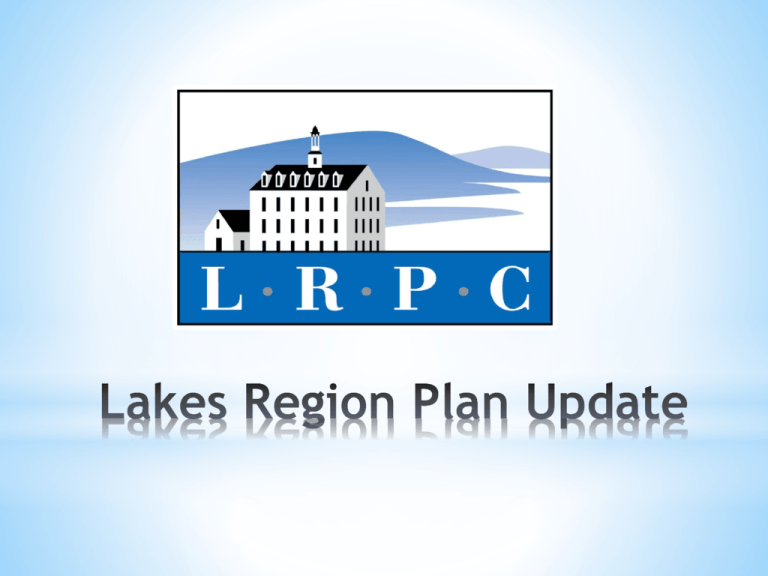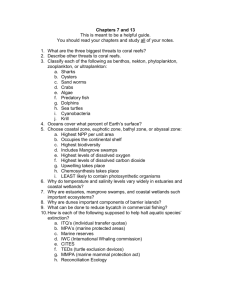Lakes Region Plan Update Presentation
advertisement

RSA 36:47: “A regional planning commission's powers shall be advisory, and shall generally pertain to the development of the region within its jurisdiction as a whole. Nothing in this subdivision shall be deemed to reduce or limit any of the powers, duties or obligations of planning boards in individual municipalities ….. . It shall be the duty of a regional planning commission to prepare a comprehensive master plan for the development of the region within its jurisdiction, including the commission's recommendations, among other things, for the use of land within the region …” Commission may accept federal funds … * Regional Planning Commissions awarded HUD Sustainable Communities Initiative (SCI) grant * State Planning effort lacking --- State Development Plan last prepared in 2000 * Grassroots / “Bottom up” approach to build regional plans * Use the regional plans as the basis for the State Development Plan * Many state and non-profit partners * Technical Advisory Subcommittee (TASC) * Comments cards – listening boxes * Review Vision Statements in local Plans * Major Lakes Region planning documents * Meetings with local officials * UNH survey * LRPC Open House – March 7, 2014 * Community of Place meeting – May 7, 2013 * Community of Interest meetings * NH Smart Growth Principles – NH RSA 9-B:2 * NH Livability Principles * * Andover: The Andover (pop 2,371 in 2010; 2,366 in 2012) Planning Board developed eight guiding principles for the Vision statement. They are: 1. Maintain Andover’s small town rural character; 2. Encourage commercial activity that builds on the regional recreation and tourism economy; 3. Create specific zones where small-scale light industry and commercial activities are allowed and encouraged; 4. Preserve views, especially along major highways; 5. Conserve natural resources – farm and forest lands, water resources, and wildlife habitat; 6. Provide choices in housing types; 7. Preserve Andover’s historical places and assets.; coordinate with Proctor Academy on our respective plans for the future; 8. Develop community infrastructure. Andover Town Hall * (Transportation) Mission statement: “To provide an integrated, all-mode transportation system in the Lakes Region which offers efficient, effective and safe movement of people and goods, and provides mode choice wherever possible while enhancing and preserving the character and livability of the neighborhoods and the natural, socio/economic, and historical environments where transportation facilities are located.” * The 2009 Comprehensive Economic Development Strategy (CEDS) Vision Statement: “Recognizing the critical importance of maintaining and nurturing our natural environment and diverse cultural heritage, the Lakes Region Community will strive to improve the quality of life of its cities and towns through the increased capacity and prosperity of its businesses, civic, social, and education institutions, and its citizens. All our efforts will be characterized by respect, communication, cooperation and integration with others and will exhibit stewardship toward our magnificent natural resources.” * Environmental protection and natural resource protection top priority for investing public dollars * Efficiency and energy choices as the second most important priority for investing public dollars. * Safe and affordable housing as the third most important priority for investing public dollars. Single family housing and assisted living facilities preferred. * Local agriculture (93%). Majorities want to encourage many other activities as well, including protecting historic buildings and neighborhoods (90%) and expanding or promoting current businesses (84%). * Quality schools the most important asset to have in their community (93%). * Maintaining bridges and highways to be the most important priority for transportation funding (77%). Residents were split on funding for other transportation initiatives. * Vast majority of residents (93%) have internet access at home, and almost all of them (91%) consider their internet access adequate for their uses. Figure 2: Priority Placed on These Community Issues (q9) * Out migration of younger people * Decline in school age population * “Greying” of NH and its implications --- healthcare, transportation, housing, care * Economic Development and job opportunities * Educational quality and affordability * Lack of internet capability * Tourism - balance w/ industry & rural character * Planning for rural character * Housing availability and affordability * Transportation * Environmental- water quality, lakes, local ag, energy * Definition – A community of people who share a common interest, goal or knowledge about something – common bond of interest. A community of interest is defined not by space or geographically but by some common bond or interest. * Groups includes - Physically disabled; Low income and below the poverty line; Racial and ethnic minorities, Senior citizens, Youth, Homeless, Immigrants and refugees and Veterans * Lakes Region Plan Advisory Committee (LRPAC) --provide guidance * Workshops --- Housing, Transportation and Environmental * LRPC and Granite State Future website --http://www.lakesrpc.org/index.asp and http://www.granitestatefuture.org/ * Vision for the Lakes Region * Telling the Lakes Region Story * Prioritized Implementation Plan & Strategies * Technical Plan Components A sense of community and sense of place Recognizing the critical importance of maintaining and nurturing our natural environment and diverse cultural heritage, the Lakes Region Community will strive to improve the quality of life of its cities and towns through the increased capacity and prosperity of its businesses, civic, social, and education institutions, and its citizens. Respect, communication, cooperation and wise stewardship of the region’s splendid natural resources are guiding principles. * Fundamental Goal: Create suitable well paying jobs, consistent with the stewardship of the region’s natural resources. * Workforce Development * New Economy * Social Capital and Cultural Heritage * Sustainability – Energy & Natural Environment * Entrepreneurship * Creative Economy * Improve Quality of Place * Safety * Project Development * Demand Management * Public Transit * Advocacy * Walking & Biking * Planning *Housing Needs Assessment *Economic and Diversity Characteristics *Housing Preferences – single family *Housing Affordability *Workforce Housing *Fair Housing & Equity Assessment *Natural Resources – Water, forest, wildlife, Air, Agricultural, land conservation, recreation *Water Infrastructure – Wastewater, drinking water, stormwater management *Issues and Concerns *Recommendations * Major Hazards in the Lakes Region- Flooding, Severe Wind, Winter Weather, Fire, earthquake * Impacts – * people, * structures (flooding, damage from falling trees, roof collapse, wildfire, conflagration, earthquake - older, multi-story buildings * Infrastructure (road washouts, culvert blowouts * sewer and water lines, power lines) * Mitigation * Anticipated changes - Increasing temperatures, especially in the winter, increase in the number of heavy rain events (>4" in 48 hrs) Less snow * Regional/global emissions * Summary of energy planning and green building * Integrating energy with traditional planning * Examples of regional successes * Local support for energy --- state and federal programs * Recommendations * By Chapter * Identify suitable local and regional projects and programs * Involve the LRPC Commissioners, local governments, non-profit organizations * Establish priorities Pictured l-r: Warren Hutchins (Laconia), Scott Dunn and John Morgenstern (Gilford). Community Viz: * The Lakes Region as a whole has developed 36% of its maximum dwelling unit potential. * Build-out population would be 310,572 (assuming existing personto-dwelling unit ratio) versus 112,735 in 2010. * Current zoning supports a density of 243 persons /Sq Mi (current density is 88 persons) * 32% of the residential development potential is in non-rural zones. Regional Economic Model Inc. REMI model – NH Bureau of Economic and Labor Market Information * Advanced Manufacturing * Entrepreneurship * Drafts completed - June 20, 2014 * Drafts submitted to NRPC – June 30, 2014 * 30 day public review starts - October 1, 2014 * Adoption by LRPC – November 24, 2014 * HUD funding ends – December 31, 2014 * How can you help? * Review draft planning documents * Identify local and regional projects for inclusion in the Implementation Plan * Keep you communities information * Note LRPC is advisory only Local Decision Making Historically, state law provides local governments with the authority to make local land use decisions. There is no interest in changing or modifying that approach. Residents believe equity is found in the local decision making process and wish to be involved in their communities and value a regional approach to land-use planning for the future in areas such as transportation, environmental quality, economic development, housing and planning for natural and man made emergencies.








